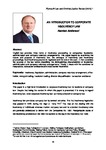An Introduction to Corporate Insolvency Law
| dc.contributor.author | Anderson, Hamish | |
| dc.date.accessioned | 2017-04-03T08:38:52Z | |
| dc.date.accessioned | 2017-04-11T11:37:26Z | |
| dc.date.available | 2017-04-03T08:38:52Z | |
| dc.date.available | 2017-04-11T11:37:26Z | |
| dc.date.issued | 2016 | |
| dc.identifier.citation |
Anderson, H. (2016) 'An Introduction to Corporate Insolvency Law', Plymouth Law and Criminal Justice Review, 8, pp. 16-47. Available at: https://pearl.plymouth.ac.uk/handle/10026.1/9038 | en_US |
| dc.identifier.issn | 2054-149X | |
| dc.identifier.uri | http://hdl.handle.net/10026.1/9038 | |
| dc.description.abstract |
English law provides three forms of insolvency proceeding for companies: liquidation, administration and company voluntary arrangements. This paper begins by examining the nature and purpose of insolvency law, the concepts of insolvency and insolvency proceedings, how insolvency practice is regulated and the role of the court. It then considers the sources of the law before describing the distinguishing characteristics of liquidation, administration and company voluntary arrangements. Finally, it deals with the sanctions for malpractice, transaction avoidance and cross-border insolvency. | en_US |
| dc.language.iso | en | en_US |
| dc.publisher | University of Plymouth | |
| dc.rights | Attribution 4.0 International (CC BY 4.0) | * |
| dc.rights.uri | https://creativecommons.org/licenses/by/4.0/ | * |
| dc.subject | insolvency | en_US |
| dc.subject | liquidation | en_US |
| dc.subject | administration | en_US |
| dc.subject | company voluntary arrangement | en_US |
| dc.subject | officeholder | en_US |
| dc.subject | wrongful trading | en_US |
| dc.subject | fraudulent trading | en_US |
| dc.subject | director disqualification | en_US |
| dc.subject | transaction avoidance | en_US |
| dc.title | An Introduction to Corporate Insolvency Law | en_US |
| dc.type | Article | en_US |
| dc.type | Article | |
| plymouth.volume | 8 | |
| plymouth.journal | The Plymouth Law & Criminal Justice Review |



